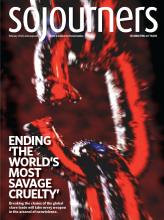THE CINEMA YEAR came to a magnificent crescendo with three films filled with what the world needs now. Hugo, Take Shelter, and The Mill and the Cross have little in common on the surface other than their quality; look deeper and you may find love-filled, theologically profound, hopeful invitations to live better.
Take Shelter is about a man terrorized by nightmares of impending doom and eventually unable to function as a loving father and husband. It’s a powerful portrayal of individual trauma and communal ignorance that takes very seriously the conventional—and counterproductive—response to recent global uncertainty. Toward the end is a sequence that could be seen as a representation of what mystics call a dark night of the soul. Then something like a conversion experience happens. Without easy answers, Take Shelter’s refusal to caricature mental illness and its embrace of the gifts of wounded people make it both a realistic and comforting story about fighting to become more human in a dehumanized world.
In The Mill and the Cross, that dehumanization appears in rich close-up, for this film takes place inside a painting, “The Way to Calvary,” the Flemish Renaissance painter Pieter Bruegel’s astonishing reimagining of Jesus’ walk to the cross through a 16th century European valley. Filled with indelible images of brokenness and love, The Mill and the Cross constitutes a religious icon. Two scenes continue to reverberate long after watching. In one, a hopeless woman observing her “heretic” husband’s execution does nothing but weep, because she lives at a time when tyranny is unquestioned. In the other, the clumsy peasant dance that writer-director Lech Majewski uses to stand in for the resurrection evokes the hope that artists such as Bruegel demand of us: to recognize that the privilege of being alive is worthy of something better than what we often give it.
Read the Full Article
